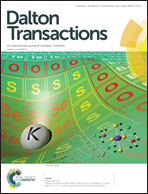Electropolymerizable peripherally tetra-{2-[3-(diethylamino)phenoxy]ethoxy} substituted as well as axially (4-phenylpiperazin-1-yl)propanoxy-disubstituted silicon phthalocyanines and their electrochemistry†
Abstract
A novel type of peripherally tetra-substituted as well as axially disubstituted silicon(IV) phthalocyanine containing electropolymerizable ligands was designed and synthesized for the first time. Axial bis-hydroxy silicon phthalocyanine 2 was prepared from 2(3),9(10),16(17),23(24)-tetrakis-{2-[3-(diethylamino)phenoxy]ethoxy}phthalocyanine 1 in dichloromethane by using 1.8-diazabicyclo[5.4.0]undec-7-ene (DBU) and trichlorosilane. Peripherally tetra and axially di-substituted silicon phthalocyanine 4 was synthesized from 2(3),9(10),16(17),23(24)-tetrakis-{2-[3-(diethylamino)phenoxy]ethoxy}silicon(IV)phthalocyanine dihydroxide 2 with 1-(3-chloropropyl)-4-phenylpiperazine 3 in toluene in the presence of NaH at 120 °C. These complexes were fully characterized by various spectroscopy techniques such as 1H-NMR, 13C-NMR, IR, UV-Vis, and MALDI-TOF spectroscopy and elemental analysis as well. Electropolymerization properties of silicon(IV) phthalocyanine complexes were investigated by cyclic and square wave voltammetry. Electrochemical studies reveal that silicon(IV) phthalocyanine complexes were electropolymerized on the working electrode during the anodic potential scan. This study is the first example of electropolymerization of both peripherally tetra and axially di-substituted silicon phthalocyanines on the same molecule.
![Graphical abstract: Electropolymerizable peripherally tetra-{2-[3-(diethylamino)phenoxy]ethoxy} substituted as well as axially (4-phenylpiperazin-1-yl)propanoxy-disubstituted silicon phthalocyanines and their electrochemistry](/en/Image/Get?imageInfo.ImageType=GA&imageInfo.ImageIdentifier.ManuscriptID=C5DT03421C&imageInfo.ImageIdentifier.Year=2015)

 Please wait while we load your content...
Please wait while we load your content...